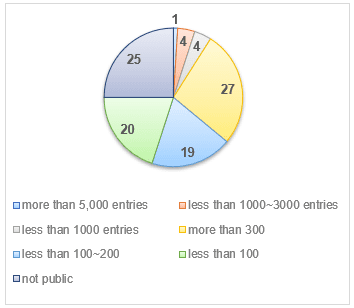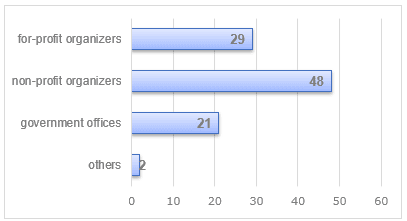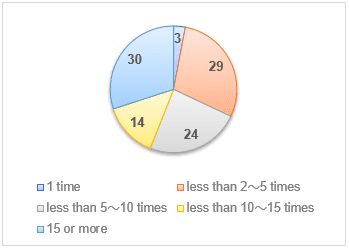Introduction
Introduction
Introduction
Digital transformation (DX) of the award business is progressing, which dramatically improves the performance of applicants, organizers, judges, sponsors, and other stakeholders, mainly in Europe and the United States.
This time, the "1st Award 100s DX Review" (August 8, 2023, ~ September 30, 2023) was held for various award programs that hold grand prizes, awards, contests, etc., with the aim of understanding the current status, sharing issues of award programs, and promoting DX in Japan.
In the review, a total of 18 items were defined in the evaluation of the DX level of the award programs (entry, judging, commendation, and performance), and the score of 100 award programs was evaluated based on the content posted on the award program website and the content of applications from related parties.
1.Review items and scoring
1.Review items and scoring
1.Review items and scoring
The review items and scores are as follows.
This review was conducted based on the content posted on the website and the content of applications from related parties (including proxy applications), both during and outside of the award program period. Some questions may be given a low score due to insufficient answers.
| criteria | Evaluation item | Score |
|---|---|---|
| Entry | 60 | |
| Announcement of award program | 10 | |
| Explanation of award program | 15 | |
| How to entry | 25 | |
| Contact applicants | 5 | |
| Smartphone compatible | 5 | |
| Judge | 60 | |
| Judging method | 15 | |
| Judging panel | 10 | |
| Evaluation Criteria | 15 | |
| Selection process | 20 | |
| Commendation | 40 | |
| Publication of applications | 10 | |
| Feedback on evaluation content | 10 | |
| Introduction of award winners | 10 | |
| Holding an award ceremony | 10 | |
| Performance | 40 | |
| Number of applications | 10 | |
| Prize Pool | 10 | |
| Application Fee | 10 | |
| Language support | 5 | |
| Supporting Organizations | 5 | |
| perfect score | 200 |
2.Top 10 Awards
2.Top 10 Awards
2.Top 10 Awards
The ratings were ranked as A+ with a score of 140 or higher, A: 130 or higher, A-: 120 or higher, B+: 110 points or more, B: 100 points or more, and B-: less than 100 points, and the top 10 award programs (grand prizes, awards, contests, etc.) were as follows.
| No | Name of award project | evaluation |
|---|---|---|
| 1 | Good Design Award | A+ |
| 2 | Nikkei Integrated Report Award | A |
| 3 | Kids Design Award | A- |
| 4 | Japan Game Awards | B+ |
| 5 | BUG Art Award | B+ |
| 6 | LEXUS DESIGN AWARD | B+ |
| 7 | S-Booster | B+ |
| 8 | TOKYO MIDTOWN AWARD | B+ |
| 9 | Nikkei Social Business Contest | B+ |
| 10 | Art Award IN THE CUBE 2023 | B |
| 10 | Asia Digital Art Award Exhibition FUKUOKA | B |
| 10 | Japan Management Quality Award | B |
| 10 | Campus Venture Grand Prix | B |
| 10 | Ichi Biz Award | B |
| 10 | Change Maker Awards | B |
| 10 | INTERNATIONAL STUDENTS CREATIVE AWARD | B |
| 10 | Publicity Conference Award | B |
| 10 | Tokyo Financial Prize | B |
| 10 | WIPO Global Awards | B |
| 10 | Cogeneration Grand Prize | B |
| 10 | All Japan DM Grand Prize | B |
| 10 | D&I AWARD | B |
| 10 | National High School Students Anything, ants. Creative Award 2023 | B |
3.Review Summary
3.Review Summary
3.Review Summary
3.1Entry Criteria
Of the 68 award programs that have a dedicated website, 34 of them, or one-half, use SNS. There were 30 award programs set up as an award menu on the general website of business organizers, of which 10 were SNS, or 1/3. A total of 44 cases have been used in SNS, and regardless of whether the award is given to an individual or a corporation, SNS is becoming established as a method of disseminating and announcing information.
There were 34 award programs that explained the award program and application methods on the relevant pages of their websites, 44 awards that also prepared PDF files, and 18 awards that explained them in introductory videos. Many of the PDF and other files were used as booklets for distribution.
Entry method

The "ID Registration + Web System," which is the most comprehensive method of accepting applications, was adopted by 16 applications, and by accepting applications through the web system, it was possible to share the burden of document and viewing selection in the screening process and to score points for each application item.
In order to prioritize the ease of application for applicants, the majority of the responses, 53 respondents, including "Web form + file upload" and "Web form input only," which utilize web forms that have been established as a simple method of acceptance.
"Sending emails such as Word/Excel" has been used for many years, and has been used in 27 cases, mainly in award programs that have been held for more than 10 years.
Due to the administrative burden of reception and the old screening process, the operation of the award business has remained in the old way to the present.
3.2Judging Criteria
The majority of 59 award programs were judged to be "documents and viewing selection only," and only the submitted content was evaluated and reviewed.
In addition to "document and viewing screening," there are 41 award programs that conduct "interviews and hearings" and "presentations and on-site visits," and the format is to narrow down the candidates in stages. In this format, the coordination of each applicant and judge, and the aggregation of the evaluation results at each stage are issues, and the DX level greatly affects the work efficiency.
Regarding the Judging panel, there were 59 disclosures of both "Judging system + principal judge", and 74 disclosures were combined with any disclosure. In addition to the disclosure of judge profiles, there were many systems in which experts in specialized fields in the award category served as judging chairs.
There are few award programs that disclose the judging system and the number of judges corresponding to the number of applications, and there are some small judging systems that seem to be difficult for each judge to handle, such as how the entries are allocated to the judges.
Evaluation Criteria

Regarding the evaluation criteria, the majority of the responses, 55, were "clearly state the criteria items." There were 18 cases of "not specifying the criteria," which undermines trust in terms of transparency, fairness, and rigor in evaluation and review. On the other hand, there are 23 cases in which detailed explanations of the criteria items are added, and the appropriate application (document preparation) for applicants and objective evaluation by the judges are encouraged.
"Completely specify the criteria items, details, and scoring" is proof that the evaluation is rigorously carried out according to them, but there were only four cases.
3.3Commendation Criteria
Regarding the disclosure of the contents of the application, 66 entries were "private", which is a format that can be seen in many award programs. On the other hand, there are 29 award programs that "disclose the contents of the final selection application" and 5 "disclose the contents of all applications" to a small number of applicants, providing an opportunity for applicants to appeal their applications to as many people as possible.
Feedback on evaluation content

Regarding the presence or absence of feedback on the evaluation content, there were 82 "notification of winning results only", which was a format that can be seen in many award programs.
There were 13 "Notification of Finalists," and only a small number of applicants were fed back during the final selection process. Regardless of whether they won or lost, only five awards were given to all applicants.
Feedback on the content of the evaluation is an operationally burdensome initiative and highlights the current lack of digital transformation.
Regarding the method of introducing award contents, 57 awards were “award page on the web'', and 75 awards included “award file such as PDF'', which is a format found in many award programs. In addition, there are 22 "introductory videos", many of which have few views and the effectiveness of the promotion is questionable.
3.4Performance Criteria
Number of applications

There were a total of 64 applications, including 20 applications of less than 100, 19 of less than 100~200, and 25 of which were "private", and many of them were small and medium-sized award programs with less than 200 applications, while 27 were more than 300 applications, which were often found in award programs sponsored by for-profit organizations.
The number of applications is related to various factors such as the number of potential applications, the recognition of the award project, the attractiveness of the award content, and the status, but establishing a brand is an important issue in order to increase the number of applications.
About half of the 52 cases answered "none" regarding prize money, and it was often seen in award programs that recognize companies and products. A total of 33 entries for "less than 3 million yen" and "less than 3 million ~ 5 million" are all considered to be motivated by the honor of winning the award rather than the prize money. On the other hand, the 6 programs for "less than 500~10 million" and the 7 programs for "10 million yen or more" are all awarded to individuals, and the high status of the award business leads to the motivation for applying.
The application fee was "free" in 86 cases, which was the majority. Of the charges, "less than 5,000 yen" and "less than 5,000~10,000 yen" in 5 cases were individual award programs, and 9 "10,000 yen or more" were corporate award programs.
Regarding language support, "Japanese only" was the majority of 79 cases. There were 15 cases of "Japanese + English" and 6 cases of "multilingual", and there are few award programs that have global value.
4.Attributes of the DX100 Review Award Programs
4.Attributes of the DX100 Review Award Programs
4.Attributes of the DX100 Review Award Programs
Type of organizer
The results of the 100 award programs reviewed this time, "Type of organizer," are as follows.

Analysis |
Compared to the 29 for for-profit organizers, there are 69 awards for non-profit organizers (incorporated associations, associations, academic societies, schools, etc.) and government offices and local governments.
The main purposes of the award program are: (1) to honor great achievements and to promote the progress and enlightenment of culture, civilization, society, etc., (2) to recognize excellent products and services, to raise market attention, and to support their growth and dissemination. (3) Commendation of new businesses and groundbreaking research and development of unknown start-up companies, to enhance their credibility (endorsement), and to trigger growth. Broadly speaking, public organizers are divided into (1) and (3), For-profit organizers tend to have many award programs aimed at (2).
Number of times held
The aggregate results of "Number of times held" of the 100 award programs that were reviewed this time are as follows.

Analysis |
Number of times held "1 time" and "less than 2 ~ 5 times" award programs have been started at the dawn of the market and industry. "5 ~ 10 times" and "less than 10 ~ 15 times held programs tend to be in the growth phase of the market or industry. "15 or more" times held programs are almost permanent award programs.
